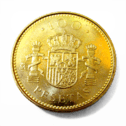Spanish peseta
The peseta (/pəˈseɪtə/, Spanish: [peˈseta])[lower-alpha 1] was the currency of Spain between 1868 and 2002. Along with the French franc, it was also a de facto currency used in Andorra (which had no national currency with legal tender).[1]
| Spanish peseta | |||||
|---|---|---|---|---|---|
| Peseta española (Spanish) | |||||
| |||||
| ISO 4217 | |||||
| Code | ESP | ||||
| Denominations | |||||
| Subunit | |||||
| 1⁄100 | céntimo (cent) (because of inflation, céntimos were retired from circulation in 1983) | ||||
| Symbol | Pta (plural Ptas), or ₧ (rare, see article) | ||||
| Nickname | perra chica (0.05 Pta), perra gorda (0.10 Pta), pela (1 Pta), duro (5 Pta), talego (1,000 Pta), kilo (1,000,000 Pta) | ||||
| Banknotes | 1, 5, 25, 50, 100, 200, 500, 1,000, 2,000, 5,000, 10,000 Ptas | ||||
| Coins | 1, 5, 10, 25, 50, 100, 200, 500, 1000, 2000 Ptas | ||||
| Demographics | |||||
| User(s) |
| ||||
| Issuance | |||||
| Central bank | Bank of Spain | ||||
| Website | www | ||||
| Printer | Fábrica Nacional de Moneda y Timbre | ||||
| Website | www | ||||
| Mint | Fábrica Nacional de Moneda y Timbre | ||||
| Website | www | ||||
| Valuation | |||||
| Inflation | 1.4% | ||||
| Source | Cámara Guipúzcoa, 1998 | ||||
| ERM | |||||
| Since | 19 June 1989 | ||||
| Fixed rate since | 31 December 1998 | ||||
| Replaced by €, non cash | 1 January 1999 | ||||
| Replaced by €, cash | 1 March 2002 | ||||
| € = | 166.386 Pta | ||||
This infobox shows the latest status before this currency was rendered obsolete. | |||||
Etymology
The name of the currency comes from pesseta, a Catalan diminutive form of the Catalan word peça (meaning piece or fraction) or the Spanish peso (weight, used a synonym for coin).[2] The word peseta has been known as early as 1737 to colloquially refer to the coin worth 2 reales provincial or 1⁄5 of a peso.[3] Coins denominated in "pesetas" were briefly issued in 1808 in Barcelona under French occupation; see Catalan peseta.
Symbol
Traditionally, there was never a single symbol or special character for the Spanish peseta. Common abbreviations were "Pt", "Pta", "Pts" and "Ptas", sometimes using superior letters: "Ptas".
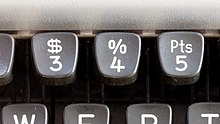
Common earlier Spanish models of mechanical typewriters had the expression "Pts" on a single type head, as a shorthand intended to fill a single type space (Pts) in tables instead of three (P+t+s).
Later, Spanish models of IBM electric typewriters also included the same type in its repertoire.
When the first IBM PC was designed in 1980, it included a "peseta symbol" "Pts" in the ROM of the Monochrome Display Adapter (MDA) and Color Graphics Adapter (CGA) video output cards' hardware, with the code number 158. This original character set chart later became the MS-DOS code page 437. Some spreadsheet software for PC under MS-DOS, as Lotus 1-2-3, employed this character as the peseta symbol in their Spanish editions. Subsequent international MS-DOS code pages, like code page 850 and others, deprecated this character in favour of some other national characters.
In order to guarantee the interchange with previous encodings such as code page 437, the international standard Unicode includes this character as U+20A7 PESETA SIGN in its Currency Symbols block. Other than that, the use of the "peseta symbol" standalone is extremely rare, and has been outdated since the adoption of the euro in Spain.
In the version 1.0 of Unicode the character ₧ U+20A7 PESETA SIGN had two reference glyphs: a "Pts" ligature glyph as in IBM code page 437 and an erroneous P with stroke. In Unicode 2.0 the reference glyph P with stroke was erroneously displayed as the only symbol for peseta[4] and was later corrected to the Pts ligature and a separate character code was added for the peso sign.
Subdivision
The peseta was subdivided into 100 céntimos or, informally, 4 reales. The last coin of any value under one peseta was a 50-céntimo coin issued in 1980 to celebrate Spain's hosting of the 1982 FIFA World Cup.[5] The last 25-céntimo coin (or real) was dated 1959, the ten céntimos also dated 1959; both coins bore the portrait of Franco. The 1-céntimo coin was last minted in 1913 and featured King Alfonso XIII.[6] The 1⁄2-céntimo coin was last minted in 1868 and featured Queen Isabel II.[7]
History
The peseta, previously a colloquial name for the coin worth 1⁄5 of a peso, was formally introduced as a currency unit in 1868, at a time when Spain considered joining the Latin Monetary Union (LMU). It replaced the old Spanish peso currency.[8] Spain eventually decided not to formally join the LMU, although it did achieve alignment with the bloc.[9] The Spanish Law of June 26, 1864 decreed that in preparation for joining the Latin Monetary Union (set up in 1865), the peseta became a subdivision of the peso with 1 peso duro = 5 pesetas. The peseta replaced all previous currencies denominated in silver escudos and reales de vellon at a rate of 5 pesetas = 1 peso duro = 2 silver escudos = 20 reales de vellón.
The peseta was equal to 4.5 grams of silver, or 0.290322 grams of gold, the standard used by all the currencies of the Latin Monetary Union. From 1873, only the gold standard applied.
The political turbulence of the early twentieth century (especially during the years after the World War I) caused the monetary union to break up, although it was not until 1927 that it officially ended.[10]
During the Civil War (1936-1939), gold and silver coinage was withdrawn and copper-nickel coins were introduced. In 1959, Spain became part of the Bretton Woods System, pegging the peseta at a value of 60 pesetas = 1 U.S. dollar. In 1967, the peseta followed the devaluation of the pound sterling, maintaining the exchange rate of 168 pesetas = 1 GBP and establishing a new rate of 70 pesetas = 1 USD.
High inflation was constant in Spain from the Civil War until the 1990s. After one century with the 1000 peseta being the largest note, the 5000 peseta note was introduced in 1976. A series of coins was issued to commemorate the 1982 FIFA World Cup held in Spain. All the decimal coinage was withdrawn in 1983; at the same time, 2000 and 10000 peseta notes were introduced.
200 and 500 peseta notes were withdrawn in 1992 and replaced by coins, leaving 1000 peseta as the smallest note. Coins ranged from 1 to 500 pesetas. In that year, a series of coins commemorating 1992 Summer Olympics in Barcelona and Expo 92 in Seville were issued. Spain was hardly hit by the early 1990s recession and the peseta was devaluated three times, the first of them being just after Black Wednesday, plummetting from 100 to 130 per USD.[11]
All Franco era coinage was withdrawn in 1997. The peseta hit rock bottom in 2000 when 200 pesetas were required to buy 1 USD.[12]
The peseta was replaced by the euro in 2002,[13] following the establishment of the euro in 1999. The exchange rate was 1 euro = 166.386 pesetas.[14]
Coins
From 1868 to 1982, a unique dating system for Spanish coins was employed. This would be adopted and sometimes abandoned intermittently during various times, and continued through to be used through the first years of Juan Carlos I's reign. Although a common "authorization date" will be found on virtually all coins of this period on the obverse (front) of each coin, the actual date for many coins can be found inside a small six pointed star, typically on the reverse (back) of each coin, but sometimes the front. Therefore, the obverse date does not always reflect the actual date of mintage but rather a restriking of older obverse coin die designs. So, if the coin date shows 1959 up front but a tiny "64" is depicted in the six pointed star on the back, then the actual date of issue is in fact 1964 rather than the date depicted in front. This dating system would be abandoned in the early 1980s anticipating a one-by-one redesign of each coin denomination.
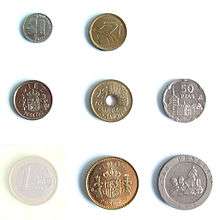
Decimal coinage of the monarchy
- No coins were issued by the short lived First Republic (1873–1874).
In 1869 and 1870, coins were introduced in denominations of 1, 2, 5, 10, 20 and 50 céntimos, and 1, 2 and 5 pesetas. The lowest four denominations were struck in copper (replaced by bronze from 1877), with the 20, 50 céntimos, 1 and 2 pesetas struck in .835 silver and the 5 pesetas struck in .900 silver. 5- and 10-céntimo coins were quickly nicknamed perra chica (small dog) and perra gorda (fat dog) respectively, as people then were unable to recognize the shape of the lion in them, mistaking it for a dog.[15] The 5-peseta coin was nicknamed duro (hard), referencing the old peso duro. 5-peseta coins were called duros by every generation until the withdrawal of the peseta in 2002, and Spaniards would often informally account in that unit (e.g. using '20 duros' for 100 pesetas).
Gold 25-peseta coins were introduced in 1876, followed by 10 pesetas in 1878. In 1889, 20-peseta coins were introduced, with production of the 25 pesetas ceasing. In 1897, a single issue of gold 100 pesetas was made. Production of gold coins ceased in 1904, followed by that of silver coins in 1910. The last bronze coins were issued in 1912.
Starting in 1906 a new series of 1- and 2-céntimo coins were issued in bronze. Due to a number of economic issues these were the only two coins from this series.
Coin production resumed in 1925 with the introduction of cupronickel 25 céntimos. In 1926, a final issue of silver 50 céntimos was made, followed by the introduction of a holed version of the 25 céntimos in 1927.
The Second Republic and Civil War period
In 1934, the Second Spanish Republic issued its first coins in the denomination of 25 and 50 céntimos and 1 peseta. The 25 céntimos and silver 1 peseta were the same size and composition as the earlier Royal issues, whilst the 50 céntimos was struck in copper. In 1937 a 5-céntimo coin was struck in iron and a new 1 peseta in brass. An iron 10-céntimo coin was also produced in 1938 but never issued into circulation, unknown whether due to its close resemblance to the 5 céntimos or because the government of issue fell before it could be released. All of these replaced symbols and images related to the monarchy. The brass 1 peseta was sometimes nicknamed La Rubia (The Blonde), as it issued a woman's face in a golden-colored alloy.[16]
Coins of the Nationalist State and World War II periods
The Nationalists issued their first official coins in 1937. These were holed 25 céntimos featuring a rising sun and a clutch of arrows. These coins were minted in Vienna. A smaller copper 25 céntimos followed in 1938. Following the end of the Civil War in 1939, the victorious Nationalist government introduced aluminium 5 and 10 céntimos in 1940 featuring a conquistador, followed by reduced size aluminium-bronze 1-peseta coins in 1944 featuring the state crest and national symbols.
During the Civil War, a number of local coinages were also issued by both Republican and Nationalist forces. In 1936, the following pieces were issued by the Nationalists:
District Denominations Cazalla de Sierra 10 céntimos Arahal 50 céntimos, 1 & 2 pesetas Lora del Río 25 céntimos Marchena 25 céntimos La Puebla de Cazalla 10 & 25 céntimos
The following issues were made by Republican forces in 1937:
District Denominations Arenys de Mar 50 céntimos, 1 peseta Asturias and León 50 céntimos, 1 & 2 pesetas Euskadi (Basque Country) 1 & 2 pesetas Ibi 25 céntimos, 1 peseta L'Ametlla del Vallès 25 & 50 céntimos, 1 peseta Menorca 5, 10 & 25 céntimos, 1 & 2 1⁄2 pesetas Nulles 5, 10, 25 & 50 céntimos, 1 peseta Olot 10 céntimos Santander, Palencia and Burgos 50 céntimos, 1 peseta Segarra de Gaià (currently Santa Coloma de Queralt[17]) 1 peseta
Franco-era coinage
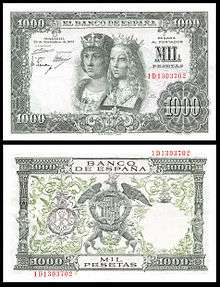
The first 1-peseta coins bearing the portrait of Francisco Franco were issued in 1947. Cupro-nickel 5 pesetas followed in 1949. In 1949, holed cupro-nickel 50 céntimos were introduced, followed by aluminium-bronze 2 1⁄2 pesetas in 1954, cupro-nickel 25 and 50 pesetas in 1958 and smaller aluminium 10 and 25 céntimos in 1959. Silver 100 pesetas were issued between 1966 and 1969, with aluminium 50 céntimos introduced in 1967. In 1966 Franco's profile was redesigned to depict a more current representation of the leader.
Following the accession of King Juan Carlos, there were a few changes. The replacement of Franco's portrait with that of Juan Carlos on the 50 céntimos and 1 peseta in 1975 and the addition of a cupro-nickel 100 pesetas in 1976. 10 céntimos were discontinued. However, more significant changes occurred to each coin in 1982. Following this redesign the 50 céntimos was discontinued, with aluminium replacing aluminum-bronze in the 1 peseta. A 2-peseta coin was also introduced featuring a map of Spain, though this denomination never became popular. More importantly, nickel brass 100 pesetas were introduced. The redesign centered around the 1982 FIFA World Cup and depicted football-related themes on the 1, 5, 25, 50, and 100 pesetas. Shortly afterwards, the large cupronickel 100 pesetas was replaced by a smaller aluminium bronze coin, which also replaced the 100 pesetas banknote. Cupronickel 10 pesetas was introduced in 1983, a denomination that had previously not been issued for many decades. This preceded a wholesale redesign in all circulating Spanish coins and abandonment of the "star" dating system. Cupronickel 200 pesetas were introduced in 1986, followed by aluminium bronze 500 pesetas in 1987.
In 1989 the biggest changes came; the size of the 1-peseta coin was significantly reduced, however not discontinued (making it the smallest, lightest circulating coin in Western Europe and perhaps the world at that time). The 2-peseta coin was discontinued. Smaller aluminum bronze 5 pesetas were introduced, and reduced aluminium bronze 25 pesetas were also introduced which had a hole in the center. Smaller 50-peseta coins were also issued the same year in cupronickel with the distinct Spanish flower shape that would eventually be used by many countries, most notably the 20-cent coin of the euro. At the same time, the 200-peseta coin was made larger and included an identifiable edge with incuse lettering. In 1999, a laser-etched hologram was added to the 500-peseta coin as a security feature to help discourage counterfeiting. During this period, all coins except the 1 and 500 pesetas went through a commemorative redesign each year, in a similar vein to the U.S. State commemorative quarters program until their discontinuation in 2001 preceding the introduction of the euro common currency.
Until 19 June 2001, the following coins were minted by the Spanish Fábrica Nacional de Moneda y Timbre:
Value Equivalent in euros (€) Diameter Weight Composition 1 Pta 0.006 (0.01) 14 mm 0.55 g Aluminium 5 Ptas 0.03 17.5 mm 3 g Aluminum-bronze 10 Ptas 0.06 18.5 mm 4 g Copper-nickel 25 Ptas 0.15 19.5 mm 4.25 g Aluminum-bronze 50 Ptas 0.30 20.5 mm 5.60 g Copper-nickel 100 Ptas 0.60 24.5 mm 9.25 g Aluminum-bronze 200 Ptas 1.20 25.5 mm 10.5 g Copper-nickel 500 Ptas 3.01 28 mm 12 gr Aluminum-bronze
The 50-peseta coins issued between 1990 and 2000 were the first that featured the Spanish flower shape.
| Spanish flower | |
|---|---|
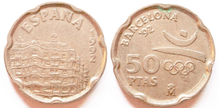 |
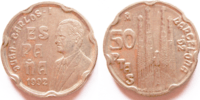 |
Spanish euro coins
Like all member nations, these coins come in denominations of 1, 2, and 5 cents in copper plated brass, 10, 20, and 50 cents in Nordic gold, and bimetallic 1 and 2 euros with a common reverse design. The obverse of the first three denominations feature Cathedral of Santiago de Compostela, the 10, 20, and 50 cents depict Spanish poet-writer Miguel de Cervantes, and the 1 and 2 euros depict the effigy of King Juan Carlos I or King Felipe VI.
Banknotes
In 1874, the Bank of Spain (Banco de España in Spanish) introduced notes for 25, 50, 100, 500 and 1,000 pesetas. Except for the 250-peseta notes only issued in 1878, the denominations produced by the Central Bank of Spain did not change until the Civil War, when both the Republicans and Nationalists issued Bank of Spain notes.
In 1936, the Republicans issued 5- and 10-peseta notes. The Ministry of Finance (Ministerio de Hacienda) introduced notes for 50 céntimos, 1 and 2 pesetas in 1938, as well as issuing stamp money (consisting of postage or revenue stamps affixed to cardboard disks) in denominations of 5, 10, 15, 20, 25, 30, 40, 45, 50 and 60 céntimos.
The first Nationalist Bank of Spain issues were made in 1936, in denominations of 5, 10, 25, 50, 100, 500 and 1,000 pesetas. 1- and 2-peseta notes were added in 1937. From the mid-1940s, denominations issued were 1, 5, 25, 50, 100, 500 and 1,000 pesetas. The 1, 5, 25 and 50 pesetas were all replaced by coins by the late 1950s.
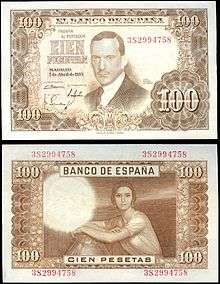
In 1978, 5,000-peseta notes were introduced. The 100-peseta note was replaced by a coin in 1982, with 1,000-peseta notes introduced in 1983, 200 pesetas in 1984 and 10,000 pesetas in 1987. The 200- and 500-peseta notes were replaced by coins in 1986 and 1987.
The final series of banknotes were introduced between 1982 and 1987 and remained legal tender until the introduction of the Euro.
Image Value Equivalent in euros (€) Dimensions Main colour Portrait 200 Ptas 1.20 120 × 65 mm Orange Leopoldo Alas 500 Ptas 3.01 129 × 70 mm Dark blue Rosalía de Castro 1,000 Ptas 6.01 138 × 75 mm Green Benito Pérez Galdós 2,000 Ptas 12.02 147 × 80 mm Red Juan Ramón Jiménez 5,000 Ptas 30.05 156 × 85 mm Brown Juan Carlos I of Spain 10,000 Ptas 60.10 165 × 85 mm Gray Juan Carlos I of Spain and Felipe, Prince of Asturias
The last banknotes series (1992) was:
| Image | Value | Equivalent in euros (€) | Dimensions | Main colour | Portrait |
|---|---|---|---|---|---|
| 1,000 Ptas | 6.01 | 130 × 65 mm | Green | Hernán Cortés and Francisco Pizarro | |
| 2,000 Ptas | 12.02 | 138 × 68 mm | Red | José Celestino Mutis | |
| 5,000 Ptas | 30.05 | 146 × 71 mm | Brown | Christopher Columbus | |
| 10,000 Ptas | 60.10 | 154 × 74 mm | Gray | Juan Carlos I of Spain and Jorge Juan y Santacilia |
Andorran peseta
The Andorran peseta (ADP) (pesseta in Catalan) was pegged at 1:1 to the Spanish peseta. Following the outbreak of the Spanish Civil War on 17 July 1936, the Andorran General Council issued Decree No. 112 of 19 December 1936, authorizing the issuance of paper money backed by Spanish banknotes.[18]
Replacement by the euro
The peseta was replaced by the euro on 1 January 1999 on currency exchange boards. Euro coins and notes were introduced in January 2002, and on 1 March 2002 the peseta lost its legal tender status in Spain, and also in Andorra. The conversion rate was 1 euro = 166.386 ESP.
Peseta notes issued since 1939 and coins that were legal tender on 31 December 2001 remain exchangeable at any branch of the Spanish Central Bank until 31 December 2020.[19] According to that entity, as of March 2011 pesetas to a value estimated at €1.7 billion had not been converted to euros.[20]
See also
- Commemorative coins of Spain
- Spanish euro coins
- Latin Monetary Union (1865–1927)
- Latin Union (since 1954)
- European Union (since 1957)
- Euro (since 1999)
- Economy of Spain
- Equatorial Guinean peseta
- Sahrawi peseta
Notes
- ^ 1999 by law (on financial markets and business transactions only), two currency units were used (the Spanish peseta still had legal tender on all banknotes, coins and personal bank accounts) until 2002.
References
- Brendan D. Brown (1979). The Dollar-Mark Axis: On Currency Power. Springer. p. 79.
- "Etimología de PESETA". Etimologías de Chile (in Spanish). Retrieved 17 June 2019.
- Royal Spanish Academy, ed. (1737). Diccionario de autoridades (in Spanish).
- Sato, Takayuki K. (2000-01-06). "Peso sign and Peseta sign (U-20A7)" (PDF). Retrieved 2015-12-26.
- 50 céntimos (1980). World Coin Gallery.
- 1 céntimo (1911-1913). World Coin Gallery.
- 1/2 céntimo (1866-1868). World Coin Gallery.
- "Peseta". Encyclopaedia Britannica.
- Charles P. Kindleberger (2005). A Financial History of Western Europe. Taylor & Francis. p. 150.
- "A Point of View: Making friends the shared currency way". BBC News. 2 March 2012.
- El paro y la devaluación de la peseta le explotan al PSOE en plena campaña. El País
- El dólar supera las 200 pesetas. El País
- "Euro becomes a reality". BBC News. 1 January 2002.
- "E-Day: The euro is born". BBC News. 1 January 1999.
- Jabalquinto School. Regional Government of Andalusia.
- Ten years without the Peseta, Muy Interesante magazine.
- Ajuntament de Santa Coloma de Queralt. "Una mica d'història". Retrieved 25 April 2013.
- Linzmayer, Owen (20 January 2012). "Andorra". The Banknote Book (1 ed.). San Francisco, CA. p. 10. Retrieved 2012-04-27.
- Peseta Exchanges. Archived 2014-02-21 at the Wayback Machine Banco de España (Bank of Spain).
- Rainsford, Sarah (March 5, 2011). "Spain town reintroduces peseta to boost economy". BBC News. Retrieved March 5, 2011.
Bibliography
- Krause, Chester L.; Clifford Mishler (1991). Standard Catalog of World Coins: 1801–1991 (18th ed.). Krause Publications. ISBN 0873411501.
- Pick, Albert (1994). Standard Catalog of World Paper Money: General Issues. Colin R. Bruce II and Neil Shafer (editors) (7th ed.). Krause Publications. ISBN 0-87341-207-9.
External links
| Wikimedia Commons has media related to Peseta. |
- Overview of the peseta from the BBC
- Banco de España (Bank of Spain): last peseta issues
- Historical banknotes of Spain (in English and German)
| Preceded by Spanish escudo |
Spanish currency 1868–1999/20021 |
Succeeded by Euro |
